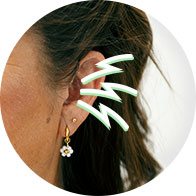Conductive hearing loss

What is conductive hearing loss?
Conductive hearing loss occurs in the outer or middle part of the ear, where sound is converted to vibrations and sent to the inner ear. This type of hearing loss refers to issues with transferring sound waves (due to a blockage or other impediment.)
Excessive earwax, a ruptured ear drum, or even ear infections can result in conductive hearing loss. If earwax has built up in the ears, conductive hearing loss may be temporary and easily corrected.


Book a free test for conductive hearing loss
What causes conductive hearing loss?
Conductive hearing loss is a type of hearing loss that is often easily identifiable. The following causes have been associated with this type of hearing loss:
- Earwax build-up - If you have a build up of earwax in the ear, this can cause temporary conductive hearing loss. The problem may be causing severe hearing loss, but it is usually easy to remedy with earwax removal. You should seek advice as soon as you notice any hearing loss, to rule out simple causes such as this.
- Ear infections - which are particularly common in childhood, can lead to a blockage in the Eustachian tube, located in the middle ear. This often causes increased pressure in the middle ear, which restricts the movement of the tiny ossicles that are so essential to good hearing. A fluid build-up caused by ear infection is another common cause of conductive hearing loss, and hearing loss caused by an ear infection can often be treated with medication.
- Changes in environmental pressure - moving into an environment where the pressure changes, such as travelling by air or up a steep hill or mountain, can cause the pressure within the hearing system to vary. For example, if you experience different pressure in the external ear to that in the middle ear, you may experience a temporary conductive hearing loss. If this persists after you have returned to an environment with a steady pressure, you should consult a doctor or audiologist.
- Otosclerosis is a genetic condition that can cause conductive hearing loss, since it leads to bony growths near the middle ear. These growths can cause difficulties with hearing, disrupting the way sounds travel through the ears and putting pressure on the delicate hearing organs.
- Other causes might be fluid in the ear or a damaged ear drum.
What is the difference between conductive and sensorineural hearing loss?
Hearing loss is divided into the following categories (based on which part of the ear is damaged): sensorineural, conductive, and mixed hearing loss.
Conductive hearing loss is usually the result of a disruption to the sound's path as it travels from the outer/middle ear to the inner ear, while sensorineural hearing loss occurs when the delicate nerve fibres of the inner ear become damaged.
Mixed hearing loss occurs when both sensorineural and conductive hearing loss occur in the same ear.
3 signs of conductive hearing loss
Conductive hearing loss is sometimes accompanied by pain or discomfort - or the feeling that "something is wrong" in the ear.
Other common signs of conductive hearing loss may include:

Treatment for conductive hearing loss
Time may be all that is needed to recover from less severe cases of conductive hearing loss. In other cases, conductive hearing loss can be treated medically in one of the following ways:
- Antibiotics and anti-fungal medications can treat hearing loss caused by an ear infection.
- Surgery may be recommended to repair damages to the eardrum or middle ear, if present.
- Hearing aids may also be an option if other forms of treatment have not been sufficient.
- Bone anchored hearing systems.




